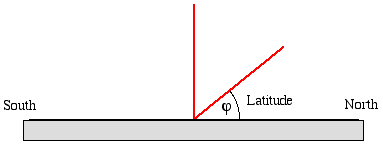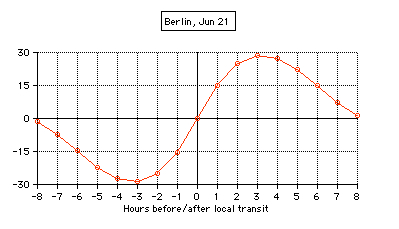|
|
GeoAstro Applets |
Astronomy |
Chaos Game |
Java |
Miscel- laneous |
Physics Quiz |
Who is Who |
A self-aligning
sundial
| This horizontal
sundial
combines two different principles and is self-aligning to true north. - The first gnomon is located in the center of the dial and perpendicular to the dial plate. Red lines are representing the azimuth angle of the Sun. - A second gnomon is ponting from the center of the dial to the north pole (i.e. parallel to the Earth's axis). Blue lines are representing the hour angle angle of the Sun.  The Sundial Garden of the Deutsches Museum (Munic) is showing this kind of dial in action ("North Finder" calculated and constructed Yves Opizzo and Christian Tobis). |
|
|
Check your time zone offset and select the local standard time. |
|
|
Click the
applet first! |
 |
Switch between azimuth and hour angle lines. |
|
|
You may use the keys "y", "m", "d", "h", "n" to increase the year, month, date, hour, minute, or Shift key and "y", "m", "d", "h", "n" to decrease the year, month, date, hour, minute ! |
 |
Click into the
spider web to get the date and the azimuth. |
  |
Check the box to choose apparent (solar) time, uncheck for standard time. |
 |
Select from the
"Options" menu. "on/off" items are working in toggle mode. |
 |
The times of
transit, sunrise, and sunset are standard time. |
| The red frame of the applet area is a square (697 x 697 pix. |
Aug 18
at 10:00 local standard time:

The
angular distance of the shadows reaches a maximum at 3 hours
before/after local transit:



Applets:
Ancient Sundials and Quadrants
|
|
|
The Sundial Primer: Spider Sundials Sonnenuhren-Spinne
(Wikipedia) Spinnensonnenuhr
/ Cadran solaire du type araignée (Yves Opizzo) |
Last Modified: 2009, Aug 12
© 2009 Juergen Giesen
![]()
